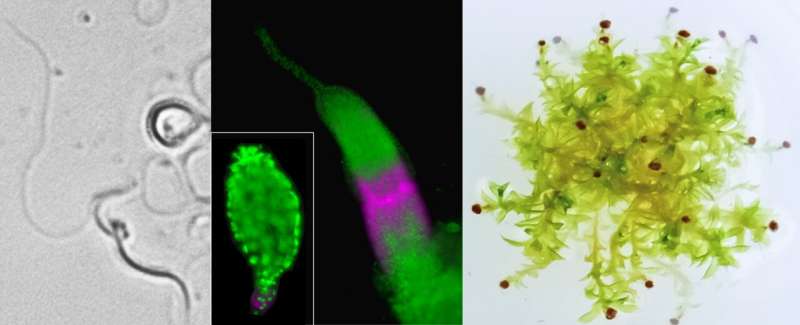This article has been reviewed according to Science X's editorial process and policies. Editors have highlighted the following attributes while ensuring the content's credibility:
fact-checked
peer-reviewed publication
trusted source
proofread
Sperm motility and anchoring of the spore capsule in spreading earthmoss

As a component of moors, mosses are important for climate conservation. They are also gaining increasing significance in biotechnology and the manufacture of biopharmaceuticals. For the most varied of reasons, mosses are interesting research objects. One reason for this is that they are particularly similar to the first land plants. As a result, they provide insight into the original function of signaling molecules which regulate growth and development in all land plants today.
Researchers at the University of Freiburg and the Excellence Cluster CIBSS—Center for Integrative Biological Signaling Studies—have discovered that transporters of the hormone auxin influence the fertility of spreading earthmoss. Their observations have been published in the scientific journal New Phytologist.
Auxin and PIN proteins regulate fertility
The hormone auxin is present in all land plants. It regulates growth and development in trees and mosses. The same is true for molecules that transport auxin and therefore control its distribution. These are known as PIN proteins. The moss Physcomitrella (Physcomitrium patens), also known as spreading earthmoss, has three different PIN proteins. Two of them are important for the growth of leaves and shoots. The function of the third protein, PINC, was by contrast unclear up to now. Spreading earthmoss in which PINC is not present apparently grow in a completely normal way.
The team working with Prof. Dr. Ralf Reski of the Faculty of Biology and the Excellence Clusters CIBSS and livMatS of the University of Freiburg, Germany, has now found out that PINC has a two-fold influence on the fertility of Physcomitrella. To make this discovery, they also examined plants exposed to low temperatures and short light periods, conditions under which this species develops both female and male sex organs.
Sperm swim better without PINC
"In Physcomitrella plants in which PINC was absent, more sperm were clearly able to swim and had straight rather than coiled flagella," says Volker Lüth, describing the team's observations. Lüth is the first author of the study and a doctoral candidate in Reski's lab.
As opposed to nearly all other land plants, mosses have sperm that propel themselves with flagella. In order to reach an egg cell, they need to swim through drops of water on the way to the female sex organs. Poor swimmers are at a disadvantage, which makes the result surprising. Reski says, "You wouldn't actually expect a molecular mechanism that reduces the fertility of sperm."
The researcher suspects one possible reason for this could be that the plants used in the lab are generally less fertile than their relatives in the wild. "In any case, our results show for the first time that auxin in spreading earthmoss plays a role in the maturation of sperm—also known as spermatogenesis," Reski adds.
Spore capsules are lost without PINC
PINC has the opposite effect on the attachment of the spore capsule, the structure that develops from a fertilized egg. In Physcomitrella it remains on the female organs, where it is attached and supplied with nutrients. If this attachment breaks, it corresponds to the abortion of an embryo, explains Reski. "If PINC is absent in the mosses, then abortions like these clearly resulted more often," he says.
Significant in this process is probably a brown ring-like structure that encircles the foot of the spore capsule. This structure has not had a name until now. "This ring is clearly recognizable under the microscope. To our knowledge, it was last described in 1909 by the German botanist Wilhelm Lorch," says Lüth. "So that's why we're calling it the Lorch Ring. It integrates auxin signals with the mechanical characteristic for the securing of the spore capsule."
In retrospect, the researchers say they are not surprised that the function of PINC remained unknown for so long. Reski explains, "We didn't suspect that auxin or the auxin transporting PIN proteins play a role in the fertility of mosses." He went on, "Add that the effect is limited to microscopic structures—you really need to take a very close look."
Reski says he now hopes that further research on mosses and other plants can build on these results. "A whole new research field could come from this," says Reski.
More information: Volker M. Lüth et al, A Physcomitrella PIN protein acts in spermatogenesis and sporophyte retention, New Phytologist (2023). DOI: 10.1111/nph.18691
Journal information: New Phytologist
Provided by University of Freiburg

















